5. INTO THE "DARK AGES"

THE COLLAPSE OF ROME IN THE WEST
CONTENTS
 The weakening and collapse of the The weakening and collapse of the
Roman imperial order
 The Germanic flood begins The Germanic flood begins
The textual material on the page below is drawn largely from my work
A Moral History of Western Society © 2024, Volume One, pages 158-165.
|
A Timeline of Major Events during this period
364 Valentinian is chosen by his troops
as emperor
375 The beginning of the Germanic threat
... with an angry Valentinian dying
378 His brother Valens is killed in a battle
with Visigoths at Adrianople
379 Theodosius rules (379-395) ...
at which point Rome becomes oficially Trinitarian
390 Ambrose of Milan faces down
Theodosius over the latter's brutality
395 Honorius and Arcadius follow father
Theodosius to office
Honorius is seated at well-protected
Ravenna
11-year old Honorius depends on
Stilicho to govern for him
Stilicho and Visigoth Alaric are in
constant contention
408 Jealous Honorius and others foolishly execute Stilicho
410 This opens the way for Alaric to
crush Rome (408, 409, 410)
But Alaric dies at sea
Augustine begins writing his The
City of God (ca. 410)
423 Honorius dies … with only
weak emperors to follow him
433 Aetius is the last great Roman
leader in the West (433-454)
Aetius holds off the various
Germanic tribes in numerous battles
452 But Atilla and his Huns finally slip past
Aetius and his worn-out army (452)
Pope Leo persuades Atilla to return north; Atilla soon dies
454 But a very paranoid Valentinian III kills
Aetius
455
But Valentian is then killed by
jealous Maximus (455)
But at this point, for all practical purposes, the
Empire is dead in the West
THE WEAKENING AND COLLAPSE OF THE ROMAN IMPERIAL ORDER |
|
The Valentinian dynasty (364-392)
Valentinian and Valens (364-378).
With Julian the "Apostate" dying childless, the military took the
initiative once again to choose their emperor, a Pannonian officer
named Valentinian. But they also demanded a co-regent so as to
assure a more secure political succession. Consequently,
Valentinian was elected to be western Augustus – and named his younger
brother Valens as Eastern Augustus.
But these would be very troubled times for Rome. By
the early 370s, the Germanic tribes were starting to act very nervous
along the Roman borders. A group of fierce central Asian nomads –
called "Huns"1 by the
Romans – had pushed westward into Germanic lands, driving the Germanic
tribes up against Rome's Rhineland border … which the tribes then
attempted to cross. So angry was Valentinian during a meeting
with a delegation of Germanic tribesmen that he suffered a stroke and
died (375).
Meanwhile in the East, Valens finally agreed to allow Germanic tribes
to settle in Roman lands along the Danube as foederati – groups who by
treaty or foedus agreed to serve as soldiers in exchange for land
rights within the Roman Empire. But these soldiers and their
families were actually treated rather contemptuously … forced to pay
high taxes and unable to afford the food they needed.
The Battle of Adrianople (378)
Thus
in 378, the Visigothic tribesmen under their leader Fritigern rose up
in revolt. Then when Valens went out to put down their revolt, he
and most of his troops were killed in the battle … and the rest
completely routed.
And this defeat would result in the loss of Rome of most of its
capable officers and veteran soldiers – and would now find it
impossible to rebuild the ranks with Romans. The Romans would
instead have to resort to the use of Germanic mercenaries to man their
legions – a difficult (and expensive) situation considering the fact
that Germanic tribes were also their natural enemies. This would
mark an important turning point in the relations between the Roman
Empire and their Germanic neighbors.
Theodosius (379-395)
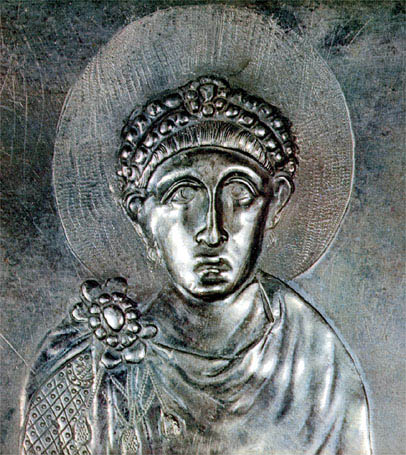
Theodosius
I
from the Missorium of
Theodosius
With
Valentinian's death in 375, the Western emperorship had gone to his
cousin Gratian. And upon Valens' death in 378, Gratian then chose
Theodosius (of a Roman family of former military leaders) as Augustus
for the East. For a while this arrangement worked fairly
well. But soon Gratian began to lose effectiveness as a Western
Augustus. His friendship with the tribesmen and his allowing
Bishop Ambrose of Milan and the Frankish (another Germanic tribal
group) general Merobaudes to actually run the Empire in the West all
acted to alienate his troops. Gratian was finally challenged by
his own troops and defeated and killed in battle.
Theodosius now co-ruled the Empire, first with one then another
individual, until 392 when his young co-ruler Valentinian II was found
hanged in his home (possibly a suicide; more probably as a result of a
fight with Arbogast, the Germanic Frankish leader who was at this point
the effective military governor in the West). Theodosius was now
the sole ruler of all the Empire, both East and West … but only for
three more years.
Rome is now officially "Trinitarian."
One of the critical developments under Theodosius's rule was the
establishment of Trinitarian Christianity as the official religion of
Rome. Up to this point, Christianity had been strongly favored
but not yet Rome's official religion. But now, under Theodosius's
orders, Trinitarian or Catholic/Orthodox Christianity became the sole
religion supported by the state. All pagan worship was to be shut
down, the Temples closed, pagan holidays ended2 … and the Vestal Virgins – the most ancient and most revered of the pagan religious icons – disbanded.
However … Theodosius's relationship with Ambrose, bishop of Milan, is
indicative of the new dynamics emerging within Christendom at that
time. In 390 Ambrose excommunicated (cut off from the privilege
of receiving the Christian sacraments) Theodosius for his massacre of
7,000 inhabitants of Thessalonica after his military governor stationed
there had been assassinated. As directed by Ambrose, Theodosius
underwent several months of public penance for this deed.
Theodosius was of course no wimp. But neither was Ambrose.
The church was in fact coming to be led increasingly by such figures of
power and authority.
Meanwhile in the East, the Germanic tribesmen continued to give Theodosius considerable trouble.
Religious troubles brewed, as there was an attempt by Eugenius, a
military usurper who seized control in the West and then – though a
Christian himself – sought to build popular support for himself there
by restoring some of Rome's pagan practices. Theodosius and
Eugenius met in battle at the Frigid River in 394, and with the help of
a "divine wind" (which turned a near defeat of Theodosius into a grand
victory) Eugenius was defeated and executed. Thus again, the
entire Empire found itself under the sole rule of Theodosius … at least
briefly. Early the next year Theodosius died of natural causes.
Honorius (nominal Western Emperor 395-423)
and Arcadius (Eastern Emperor 395-408)
The Empire now passed to his two sons, Honorius ruling in the West
(with his capital at Milan, and then later Ravenna)3 and Arcadius ruling
in the East (from Constantinople). The Roman Empire was again
divided ... never to be united again. Actually from this point on
the Western Empire fell increasingly under the control of the Bishops
of Rome and various semi Roman / semi German or even fully German
military strongmen or "patricians" (such as Arbogast – and subsequently
Stilicho). The Western emperors would rule in name only.
Honorius (W. Emperor 395-423)
and Arcadius (E. Emperor 395-408)
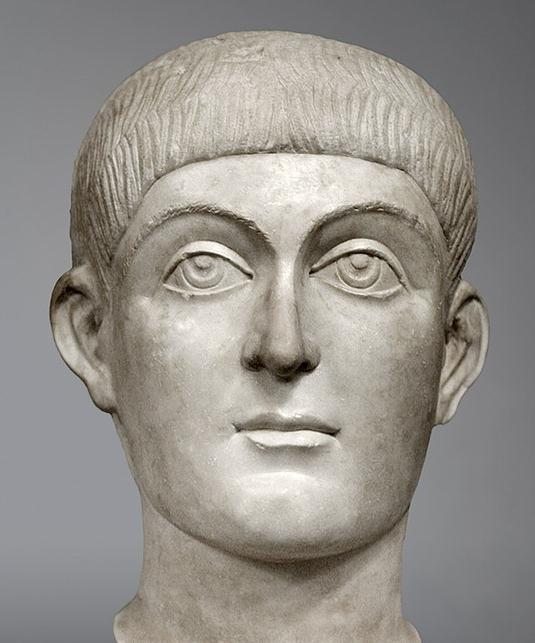 Honorius - Western Emperor Honorius - Western Emperor
(395-423)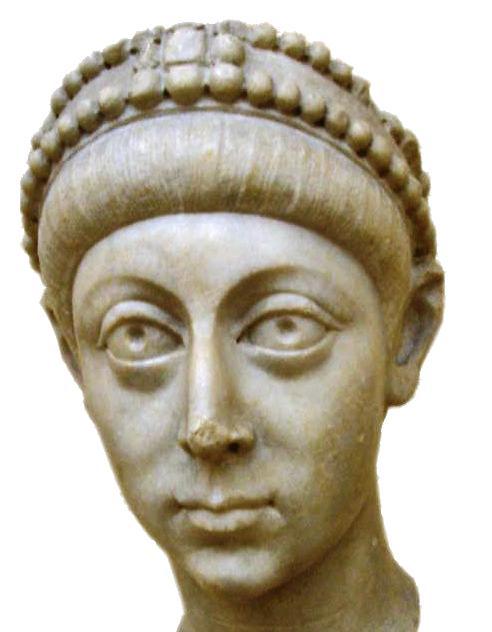
Arcadius
- Eastern Emperor
(395-408)
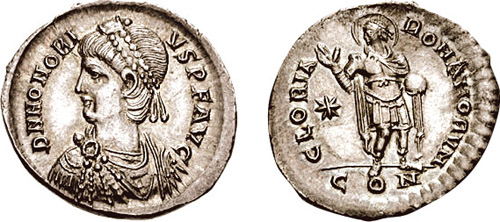
Silver siliqua coin glorifying
Honorius
Stilicho the "Patrician" versus Alaric the Visigoth
As
the 11-year-old Honorius became officially emperor of the Western
Empire, Flavius Stilicho became de facto governor of the West.
Stilicho was born a Roman mother, but a Germanic Vandal father.
In his upbringing he was treated entirely as "Roman." He rose
quickly within Theodosius's army and ultimately was given the task by
the emperor of defending the Empire against the Visigoths. In the
battle between Theodosius and Eugenius in 394, Stilicho was one of the
generals who – along with a major storm (the "divine wind") – helped
turn the battle in favor of Theodosius. Theodosius was so
impressed by Stilicho's performance that he appointed him guardian of
his son Honorius just prior to his death in 395
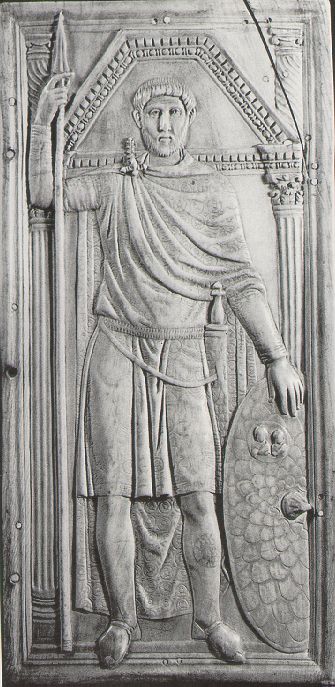
German-Roman general Stilicho
Copy of an ivory carving.
The original diptych, carved circa 395, is in Monza (Italy)
Römisch-Germanisches
Zentralmuseum,
Mainz, Germany
Holding off Alaric and his Visigoths
As Honorius became officially emperor of the Western Empire, Stilicho
became de facto governor of the West. His main task would be to
stop the rise of his former colleague, the Visigothic foederati
commander Alaric, who had replaced Fritigern as leader of the
Goths. With Alaric threatening the Eastern Empire in Thrace in
395, and the Eastern Roman army fully occupied further east in battle
against the Huns, this left Stilicho the full responsibility of
stopping Alaric.
Alaric
Alaric was a Visigoth chieftain principally interested in becoming
recognized within the Roman Empire as a military "protector" over the
imperial household. He was rebuffed in his effort to do this
through a normal rise up the ranks of the military – and thus Alaric
took to conquering. Recognition, not plunder, seemed consistently
to remain his aim in life.
Alaric was born around 370 to a noble Gothic (Western Gothic or
Visigoth) family, who had just fled south to the mouth of the Danube
River at the Black Sea to escape the invasion of Eastern Europe by the
Asian Huns. As a young man Alaric served in the army of the
Gothic foederati – becoming a general in 394 and serving under the
Emperor Theodosius. At this point he began to take note of the
weakness of the Roman hold over northeastern Italy.
When he was later bypassed by Theodosius's sons, Arcadius and Honorius,
in their distribution of imperial offices, Alaric made the decision to
act on his own political behalf. Gathering disgruntled foederati
(for whom tribute payments from Rome had been slacking off) he had
himself proclaimed Gothic king. He then moved his troops on
Constantinople itself. But unable to take this well defended city
(stopped by Stilicho), he turned his troops towards Greece
proper.
The battle between Alaric and Stilicho intensifies
Then he found himself trapped in Greece by Stilicho. But just as
Stilicho was in a position to destroy Alaric and his army, Arcadius
(the eastern emperor) strangely ordered Stilicho back to the
west. This allowed Alaric to pillage the lands of Thrace and
Greece for almost two years (395 396) – though he spared Athens.
In 397 Stilicho again moved against Alaric – crushing his army
(although Alaric himself escaped into the mountains) – but managed to
escape to the north along the eastern Adriatic Sea (Illyricum), where
he was welcomed as a liberator, king of the lands that reach even up to
the middle Danube River.
Then Stilicho was sent that same year to put down rebellion in
Africa. His reputation now was so great that in 400 the Senate
named him "consul."
In the meantime, Alaric conducted a devious diplomacy with the Eastern
and Western branches of the Roman Empire – swearing fealty to one or
another as he felt it opportune to do so. At the same time he
began to equip his troops with the finest of Imperial weapons.
The next year (401) Alaric broke a treaty with Stilicho and arranged an
alliance with Radagaisus, chief of a number of German tribes, with the
intention of raiding and pillaging Italy. He spread terror
through northern Italy – until in 402 he and the German coalition were
met and defeated by Stilicho along the Danube (Radagaisus) and at
Polentia (Alaric) – which Alaric had laid siege to. Again, Alaric
escaped. They met again in 403 and again Alaric was defeated –
but escaped.
1The
precise origins of the Central Asian Huns remain a mystery … though the
Huns certainly came to Europe by way of the steppes of Southern Russia
– possibly fleeing an extensive drought that hit central Asia about
this time.
2The
ones anyway that had not yet turned themselves into Christian holidays
… such as the year's end celebration of Saturnalia – which turned
itself into Christmas!
3Honorius had ultimately moved the Western capital from the besieged
city of Rome … to the well protected town of Ravenna – well-protected
because of the surrounding swamps which made siege by any enemy almost
impossible. Ravenna – not the declining city of Rome – would
serve as the capital of the Western half of the Roman Empire for quite
some time.
THE GERMANIC FLOOD BEGINS |
But at the end of 406 Stilicho was unable to stop a massive raid of
German tribesmen across the frozen Rhine – and the subsequent
widespread pillaging of Gaul. Stilicho's army had become depleted
by its several battles with Alaric and he could offer no serious
resistance to the raiding parties which were running wild across Gaul.
Also, though defeated, Alaric was not considered out of the political
picture. Indeed, in the mounting tensions between the Eastern and
Western Imperial governments, he was called in for support by even
Stilicho ... a development that Stilicho's enemies would soon use to
bring him down.
Also Alaric, who had moved his armies into Greece, seeing mounting
weakness in Rome's (Stilicho's) defensive forces became so bold as to
demand a huge tribute payment as the price of peace. Stilicho
recommended payment ... and the Senators refused to go along with the
idea ... although they had no alternative plan to deal with the
mounting German problem.
Stilicho's fall (408)
Instead Stilicho's political opponents (which now included Honorius),
who had become very jealous of Stilicho's popularity and fearful of his
support among the Roman troops began to spread wild rumors about his
complicity with Alaric – which successfully alienated sections of
Stilicho's army which rose up in revolt against Stilicho.
Stilicho's enemies now felt that they had good ground to have Stilicho
arrested ... and executed (408). Stilicho's son was soon executed
after him.
Confusion now reigned as Roman troops went on a rampage ...with Roman
soldiers turning on the German foederati soldiers and their families in
Roman cities. The slaughter was extensive, and the German
survivors fled the Empire ... added enormously to the ranks of Alaric's
army.
Alaric's first attack on Rome (408)
Now Alaric struck back ... and laid siege to Rome. Finally, with
hundreds of thousands of Romans trapped inside the city ... and slowly
starving, and no signs of help coming from the Eastern Empire – or even
the Western imperial authorities in Ravenna – Alaric was bought
off by the citizens of Rome themselves with an impossibly high ransom,
which stripped the city of most of its wealth ... and certainly its
honor.
But Alaric still pressed for Roman recognition of some kind of official
position within the Empire: rule over the lands between the
Northern Adriatic and the Middle Danube and the command of the Imperial
army. Failing satisfaction in this, he besieged Rome a second
time (409) – and gained the position from the Senate as unofficial
overlord of an imperial usurper, Attalus.
But Attalus proved not to be a compliant vassal – and not greatly
competent. He brought Rome to defeat in Northern Africa where
Rome depended heavily for its grain imports. The Romans began to
complain bitterly about this new regime of Alaric and Attalus.
Alaric consequently dumped Attalus (who nonetheless years later would
reappear as an imperial claimant and thus greatly trouble Roman
politics) and attempted to negotiate a deal with Honorius – but was out
trumped diplomatically with the intervention of a Gothic rival, Sarus.
Alaric sacks Rome (410)
But the Roman authorities in Ravenna still could not or would not meet
Alaric's political demands ... which included the removal from power of
Honorius. Failed negotiations and treachery on all sides finally
determined Alaric to once again move on Rome. Alaric's troops
broke through one of the gates ... and for the next three days
plundered Rome ... sending Roman citizens scattering around the rest of
the Empire as refugees, where often an even worse fate (slavery,
prostitution, etc.) awaited many of them.
Having taken what he wanted in wealth from the city of Rome, Alaric
then headed south through the rest of Italy, with the intention of
taking by force the grain lands of North Africa – thus bringing some
contentment to his Roman subjects. But storms destroyed his navy
– and Alaric himself was struck by fever and died in the effort (also
410), bringing to an end the life of this amazing self defined
adventurer.
Overall – despite his ultimate failure at establishing some kind of
Gothic regime of his own, Alaric left an huge mark on his age.
Principally, he had exhausted the Roman resistance in the West, and
opened the way for the various German tribes to invade Gaul and
Spain. It was his marauding of Rome that also caused the
withdrawal of the Roman legions from Britain in 410 (to protect the
Italian homeland from Alaric) – leaving Britain vulnerable to the
invading Picts and Scots to the North and the Saxons to the East.
Passing around the blame
Paganism had by no means been eradicated in Rome with its embrace of
Christianity ... and immediately the two religious groups laid blame
for the city's humiliation at the feet of their opponents, each
claiming that it was the failure of the other's God or gods that had
brought this curse on Rome ... with the stronger argument seeming to
lie with the pagans (though Augustine would offer a very effective
answer of his own with his work, The City of God, written at this time.)
Whatever was the "divine cause," the net effect was a sense of curse
that had fallen on Rome. Its centuries-old image as the power
center of Western Civilization was shattered ... and in its place Rome
now appeared to be a poor, broken city, a mere shadow of its former
greatness.
And such an image of weakness would become simply an invitation for
other rising powers beyond the Empire to see the Roman Empire – at
least in the West – as an easy target. For the German tribes of
north central Europe (Goths, Franks, Alemanni, Burgundians, Angles,
Saxons, Frisians, Thuringians, Vandals, etc.), the rush to move into
the western half of the Roman Empire now began in earnest.
|

Alaric sacking Rome - by Andre Durenceau
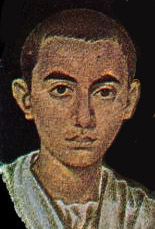 The Empire exhausts itself in foolish in-house power struggles The Empire exhausts itself in foolish in-house power struggles
These
were times of tremendous turmoil for the Empire. Various
claimants to imperial power (Constantine III, Sebastianus, another
Maximus, – and, again, Attalus) drained away Roman power as they fought
each – at a time when Rome needed all the resources it could muster
just to control the influx of Germans. Honorius kept himself in
power with the help of some able generals – and a lot of
negotiating. Finally he died in 423, leaving no heir. The
eastern emperor Theodosius III named his six year old cousin Valentinian III as Western emperor.
Flavius Aëtius: the last great Roman leader in the West (433-454)
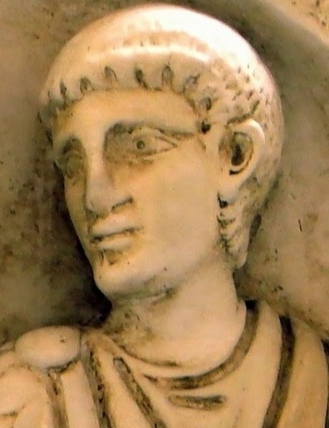 In
its continuing struggle for survival, the Western Empire was well
served for twenty years by the Roman general Aëtius, born of an
aristocratic Italian mother and a Roman general of German
ancestry. Aëtius began his career as a general commanding Hun
troops and supporting an unsuccessful contender to the imperial
throne. But his arrival before Rome with his Hun army was so
impressive that Valentinian's mother, Galla Placidia, the effective
ruler of Western Rome (or whatever was left of it) agreed to name him
head of the Roman army in Gaul if he sent his Huns back outside Rome's
borders. This he did. In
its continuing struggle for survival, the Western Empire was well
served for twenty years by the Roman general Aëtius, born of an
aristocratic Italian mother and a Roman general of German
ancestry. Aëtius began his career as a general commanding Hun
troops and supporting an unsuccessful contender to the imperial
throne. But his arrival before Rome with his Hun army was so
impressive that Valentinian's mother, Galla Placidia, the effective
ruler of Western Rome (or whatever was left of it) agreed to name him
head of the Roman army in Gaul if he sent his Huns back outside Rome's
borders. This he did.
He then turned his attentions to the Visigoths, forcing them to retreat
to southwestern Gaul, and the Franks, retaking some of the land along
the Rhine which they had seized. One by one he faced other German
tribes – forcing them also into submission.
Meanwhile he had battles of his own within the Roman political circles
– principally against Boniface, his primary military commander.
He eventually defeated Boniface, and was declared supreme military
commander (patrician) in the West. The he turned his attentions
again to the Germans: the Burgundians (whom he decimated), the Suebi,
the Visigoths, the Alans – settling each of them in more or less stable
situations around the Western Empire under some form of treaty
arrangement.
Attila and the Huns
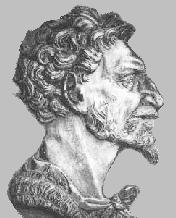 Meanwhile another problem presented itself ... this time in the form of the Huns, and their leader Attila. Meanwhile another problem presented itself ... this time in the form of the Huns, and their leader Attila.
Attila was born near Budapest in Central Europe to the royal family of
Huns. In 433 he became king of the Huns and began the process of
turning his tribesmen into a powerful fighting instrument. With
his new army he brought the German tribes (Ostrogoths) around the Huns
under their sway.
Then in 448 452 Attila, having reorganized the Huns of Central Europe
into a new fighting machine, marched into the very heart of the Roman
Empire. Claiming to defend the honor of Honoria, granddaughter of
the Eastern Emperor Theodosius II, he pressed her cause all the way up
to the gates of Constantinople. He attacked Constantinople in 448
and was bought off with ransom money.
Then he turned westward in 451 with his huge Hunnic Germanic army
against the Emperor of the West, Valentinian III – again claiming to
defend Honoria's honor. He ravaged Gaul (France) and was about to
lay waste to Orleans along the Loire River when a huge coalition of
Romans, Visigoths, Franks and Alemanni led by Aëtius gathered to fend
off Attila at the Battle of Châlons. The devastation was vast on
all sides of the conflict. Theodoric, king of the Visigoths, was
killed. But Attila was also forced to retreat back behind the
Rhine.
But the next year (452) Attila slipped past Aëtius in the Alps and
descended down upon northern Italy – to burn and pillage city after
city. Aëtius, with a greatly depleted army, did what he could to
slow up Attila's advance. Attila stopped at the Po River and
received a Roman delegation (including Pope Leo I) – which convinced
him to return north of the Alps (hunger among his troops and an attack
on his homebase in the north by other Roman legions also contributing
factors). Then before the waiting world could see what he would
do next, he died suddenly at the feast celebrating his marriage to
Ildico.
Valentinian III brings the Roman Empire to its death
in the West (454-455)
Meanwhile Valentinian was growing paranoid about Aëtius's popularity
and power and was easily convinced by ambition conspirators (Maximus
and Heraclius) of the need to assassinate Aëtius, which in 454
Valentinian did by his own sword – thus eliminating the one source of
strength Rome possessed during his emperorship. But then when
Maximus found that Valentinian did not name him as Aëtius's
replacement, he turned against Valentinian and his co-conspirator
Heraclius and had them both murdered … while soldiers who had come to
love Aëtius, though standing close at hand, did nothing to stop the
murders.
Valentinian would be followed by a rapid succession of Roman emperors,
each reigning for only a few years, some only for months or even
days. Finally, only two decades later, the fiction of a Roman
ruling as Western Emperor was brought to an end. The Western
Empire was gone.
|
 Miles
H. Hodges Miles
H. Hodges
| | |


 The weakening and collapse of the
The weakening and collapse of the










